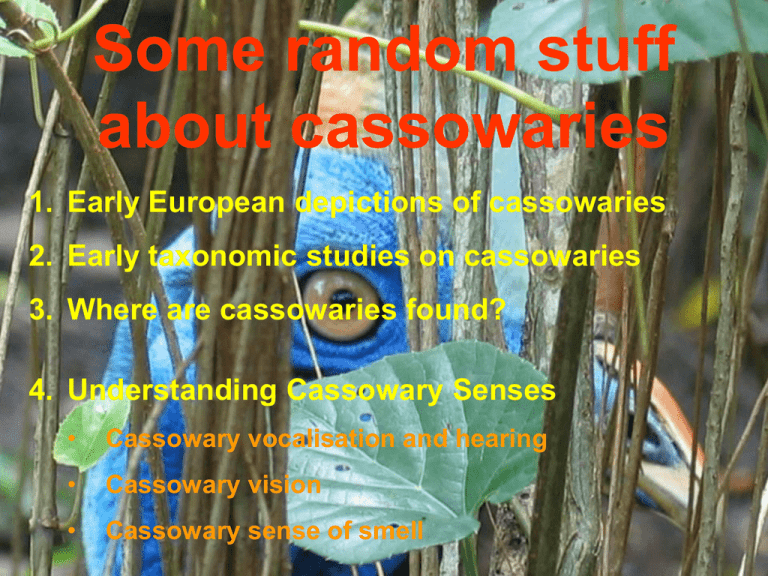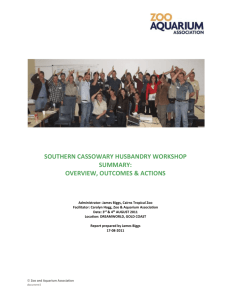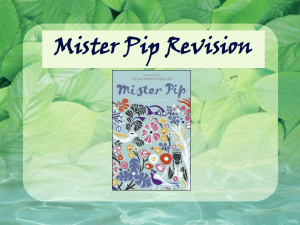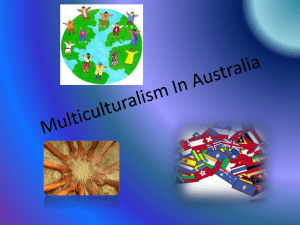Cassowaries in the New Guinea rainforests
advertisement

Some random stuff about cassowaries 1. Early European depictions of cassowaries 2. Early taxonomic studies on cassowaries 3. Where are cassowaries found? 4. Understanding Cassowary Senses • Cassowary vocalisation and hearing • Cassowary vision • Cassowary sense of smell Cassowary painting by Francis Barlow in the Entrance Hall at Clandon Park, Surrey 1670’s. Also included in Ornithologia (1676) which was one of the first modern scientific treatises on birds. Bird Engravings by Eleazer Albin Cassawar cock 1730’s George Louis Leclerc Buffon and Francois Nicolas Martinet Casoar des Indes orientales 1770's When live birds began to arrive in Europe, the details of illustrations greatly improved but the habitat detail was incorrect John Gould Southern Cassowary (Casuarius casuarius), watercolour (c.1850) Australian Cassowary, reproduced from The Birds of Australia, supplements by John Gould, London 1851, vol. 1 (5parts) Image: Artist John Gould / Lithographer H. C. Richter Source: Museum Victoria Cartoon of 1868 But the Voracious Bird does his best to prevent the missionary from ever doing so. Hence the doggerel: “Where stalked the dusky Cassowary, On the plains of Timbuktoo; There he ate the missionary, Beads and prayer, and hymn-book too.” Lord Walter Rothschild (1868-1937) [shown here with his trained zebra] His most fanatical interest were in: * Birds of paradise * Fleas * Cassowaries In December 1900, Walter Rothschild published his seminal work on the cassowary. Casuarius casuarius beccarii Casuarius casuarius bicarunculatus The work included exquisite plates by the bird artist John Gerrard Keulemans. Casuarius casuarius intensus Casuarius casuarius salvadorii The first cassowary specimen described in Australia was named by Wall as Casuarius australius (1848). The second specimen was named Casuarius johnsoni by Mueller (1866). The Australian cassowary was later recognised as a subspecies of Casuarius casuarius which is also found in PNG. There are currently three recognised species of cassowary: • C. casuarius described by Linnaeus in 1758 • C. bennetti described by Gould in 1857 • C. unappendiculatus described by Blyth in1860 Dwarf Cassowary Casuarius bennetti Mostly montane 20-30 kg Dwarf Cassowary •Casuarius bennetti occurs in New Guinea (Papua, formerly Irian Jaya, Indonesia and Papua New Guinea). •It is a forest species occurring into the mountains and occasionally to the treeline at 3,600 m. Northern Cassowary Single-wattled Cassowary Gold-necked Cassowary Blyth’s Cassowary Casuarius unappendiculatus Least known of the 3 spp. Mostly lowlands up to 50 kg? Northern Cassowary (Single-wattled cassowary) H • a Casuarius b unappendiculatus is i t restricted to the northern a t lowlands of New Guinea a (Papua, formerly Irian n d Jaya, Indonesia, and E c Papua New Guinea). o l o g y : • inhabits lowland forest, including swamp-forest, to 700 m. Its ecology is poorly known but presumed to be similar to that of C. casuarius. Southern Cassowary Double-wattled Cassowary Casuarius casuarius Southern NG and northern Australia 50+ kg Southern cassowary (Double wattled cassowary) •Casuarius casuarius is found in New Guinea (Papua, formerly Irian Jaya, Indonesia and Papua New Guinea), including the islands of Seram and Aru, and north-eastern Australia. •It occurs throughout the southern lowlands of New Guinea, eastern Cape York Peninsula and Wet Tropics of Queensland Casuarius unappendiculatus Northern Casuarius bennetti Dwarf Casuarius casuarius Southern The 8 Subspecies of the Southern Cassowary (Casuarius casuarius) Subspecies Distribution Casuarius casuarius casuarius Ceram island Casuarius casuarius bicarunculatus Aru island & northern New Guinea Casuarius casuarius tricarunculatus Geelvink Bay in New Guinea Casuarius casuarius lateralis Northern New Guinea Casuarius casuarius sclaterii Southern New Guinea Casuarius casuarius aruensis Wokan Island Casuarius casuarius violicollis Trangan Island Casuarius casuarius johnsonii Far North eastern Australia Understanding Cassowary Senses • Cassowaries depend on their senses for survival • Cassowaries have evolved their senses to maximise their survival • Cassowaries have the same senses humans do – sight, hearing, touch, taste and smell – but they are specialised to help them survive. Sensory Research Studies directed at gaining an understanding of cassowary communication and perception. • • • infrasound communication and its effects on behaviour colour perception and its influence on sight, food preferences (and a range of other behaviours) sense of smell and how this might influences food preferences, location, interaction etc. Communication • among the lowest known frequencies produced by birds • components inaudible to many people • low frequencies travel well through rainforest • purposes unknown– possibly territorial and /or attraction over long distances • similarities to casqued dinosaurs?? Infrasound Southern Cassowary Dwarf Cassowary pulsed harmonics 25, 50, 75, 100 Hz Vision At ground level in a rainforest 95% of the light is blocked out by the canopy. Colour is not an inherent property of an object - it is a property of the nervous system of the animal perceiving the light. Humans – only 3 cone types: red, green and blue (trichromatic vision) Birds – 4 cone types: includes UV Colour Perception • Colour perception in cassowaries is very different to the way humans see the world • Implications in determining food preference and in understanding and manipulating a large range of behavioural responses. Sense of SMELL in cassowaries • The sense of smell in birds varies greatly between species depending on the size of their olfactory bulb - the brain region involved in sense of smell. • Most bird species have very small olfactory centres in their brains, and they do not use smell extensively • More evolutionary advanced bird species devote more brain space to visual and sound signals at the expense of their sense of smell. • Kiwi has a very abnormally large olfactory bulb – is this true of other ratites?









